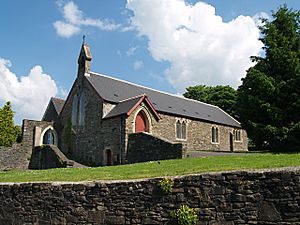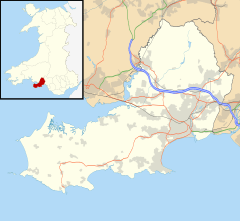Birchgrove, Swansea facts for kids
Quick facts for kids Birchgrove
|
|
|---|---|
| Suburb of Swansea | |
 Glais Church |
|
| Population | 7,392 (2011) |
| OS grid reference | SS704981 |
| Community |
|
| Principal area | |
| Country | Wales |
| Sovereign state | United Kingdom |
| Post town | SWANSEA |
| Postcode district | SA7 |
| Dialling code | 01792 |
| Police | South Wales |
| Fire | Mid and West Wales |
| Ambulance | Welsh |
| EU Parliament | Wales |
| UK Parliament |
|
| Welsh Assembly |
|
Birchgrove (which is Y Gellifedw in Welsh) is a lively suburb and community in Swansea, Wales. It's part of the United Kingdom. This area is located about 4.5 miles (7 km) north-east of Swansea city centre. It sits between the flood plain of the River Tawe and a mountain called Mynydd Drumau. In 2011, about 7,392 people lived in Birchgrove.
Contents
What's Birchgrove Like?
From the top of Mynydd Drumau, you can see amazing views. You can look out over the Swansea, Neath, and Blaengwynfi valleys. On a clear day, you might even spot the coast of Devon across the Bristol Channel. It's a great spot for seeing far away!
Learning in Birchgrove
Birchgrove has both a primary school and a comprehensive secondary school. Both schools are run by the state. They welcome all students, boys and girls, and are not linked to any specific religion.
Birchgrove Comprehensive School opened in 1991. It was built on the land where the old junior school used to be. This school serves students from Birchgrove, Glais, and Clydach. Most students from Birchgrove Primary School continue their education here when they turn 11. However, some students from Glais and Clydach might go to Cwmtawe Community School in nearby Pontardawe. Also, some students from Llansamlet and Trallwn choose Birchgrove instead of Cefn Hengoed Community School.
A Look Back: Birchgrove's History
Birchgrove has a long and interesting past. People have lived here for thousands of years!
Ancient Times
The countryside around Birchgrove is full of ancient sites. You can find many old barrow mounds. These are like small hills where people were buried long ago. There is also proof that prehistoric people lived here.
One special landmark is Carreg Bica. It's a very large standing stone on Drummau Mountain. This stone is made of local sandstone and stands about 13 feet (4 meters) tall. Its name means "pointed stone" in Welsh. It's also known as Maen Bredwan or Maen Bradwen. This stone was even mentioned in a document from 1203. It was used as a boundary stone to mark the edge of the Gower Peninsula.
There's a fun legend about Carreg Bica. People say the stone moves! It's believed to go to a local stream to drink or bathe. Some stories say it bathes in the River Neath every Easter morning. Children from Skewen used to race to the stone on Easter morning to see if it was true!
In the early 1100s, Cistercian monks built the nearby Neath Abbey. They used Drummau Mountain for their animals. In winter, they kept their flocks and herds in the valley. During other seasons, they moved them to stone-walled fields they built on the mountain top. Carreg Bica helped them find their way. Many parts of these old stone walls from the monks' time are still standing today.
The Industrial Age
From very early times until the 1800s, coal-mining was very important in Birchgrove. The villages in the area grew because of coal mining. Birchgrove was a big part of this. Mining played a huge role in the growth of the lower Swansea Valley. This area became a world leader in working with metals. (You can learn more about this in the History of Swansea article.)
Coal started to replace wood for melting metal ores. Because of the high demand for coal, a mine was dug in Birchgrove. It was called Birchgrove Colliery Company, but people locally called it the 'Old Pit'. It was located just below the Birchgrove Post Office. The mine opened in 1845 and was about 100 feet deep.
Because the 'Old Pit' was so successful, two more mines were opened: Sisters Pit and Brothers Pit. About 200 people worked at the 'Old Pit'. This brought many new people to the area. They came to work in both coal mining and the copper industry.
The only place for fun and learning back then was a Reading Room near the mine. It wasn't used on Sundays. So, the villagers were allowed to use it for church services. These services followed the rules of the Church of England. They were very popular. The Birchgrove Colliery closed down in 1931.
You can still see signs of Birchgrove's industrial past today. The ruins of Scot's pit pump house stand at the lower end of Birchgrove. You can also find evidence of old mine workings in the area.
Nearby Places
- Llansamlet
- Swansea Vale
- Glais
- Skewen


